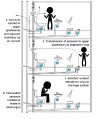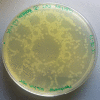Pathogen cross-transmission via building sanitary plumbing systems in a full scale pilot test-rig
- PMID: 28187135
- PMCID: PMC5302810
- DOI: 10.1371/journal.pone.0171556
Pathogen cross-transmission via building sanitary plumbing systems in a full scale pilot test-rig
Abstract
The WHO Consensus Document on the epidemiology of the SARS epidemic in 2003, included a report on a concentrated outbreak in one Hong Kong housing block which was considered a 'super-spreading event'. The WHO report conjectured that the sanitary plumbing system was one transmission route for the virus. Empty U-traps allowed the aerosolised virus to enter households from the sewerage system. No biological evidence was presented. This research reports evidence that pathogens can be aerosolised and transported on airstreams within sanitary plumbing systems and enter buildings via empty U-traps. A sanitary plumbing system was built, representing two floors of a building, with simulated toilet flushes on the lower floor and a sterile chamber with extractor fan on the floor above. Cultures of a model organism, Pseudomonas putida at 106-109 cfu ml-1 in 0·85% NaCl were flushed into the system in volumes of 6 to 20 litres to represent single or multiple toilet flushes. Air and surface samples were cultured on agar plates and assessed qualitatively and semi-quantitatively. Flushing from a toilet into a sanitary plumbing system generated enough turbulence to aerosolise pathogens. Typical sanitary plumbing system airflows (between 20-30 ls-1) were sufficient to carry aerosolised pathogens between different floors of a building. Empty U-traps allowed aerosolised pathogens to enter the chamber, encouraging cross-transmission. All parts of the system were found to be contaminated post-flush. Empty U-traps have been observed in many buildings and a risk assessment indicates the potential for high risk cross-transmission under defect conditions in buildings with high pathogen loading such as hospitals. Under defective conditions (which are not uncommon) aerosolised pathogens can be carried on the airflows within sanitary plumbing systems. Our findings show that greater consideration should be given to this mode of pathogen transmission.
Conflict of interest statement
MG is a named inventor on a Patent for a defective trap identification system. MG received funding to do the research from Dyteqta Ltd. who played no role in study design, data collection, data analysis, data interpretation, or writing of the report. The corresponding author had final responsibility for the decision to submit for publication. TJA DAK and CR have declared that no competing interests exist. Patent details (Michael Gormley named inventor): Faulty Trap Identification system - Patent no. GB2441788 publication date 9th November 2011 and US 2010/0000298A1 - publication date Jan 7 2010. Patent owned by Heriot-Watt University and licensed to Dyteqta Ltd. This does not alter our adherence to PLOS ONE policies on sharing data and materials.
Figures






References
-
- Moore G and Walker JT. Presence and control of Legionella pneumophila and Pseudomonas aeruginosa biofilms in hospital water systems in: Percival SL, Randle J,Cooper T and Williams D. (Eds.) Biofilms in Infection Prevention and Control–A Healthcare Handbook. Elsevier: 2013.
-
- ANSI/ASHRAE Legionellosis: Risk Management for Building Water Systems. Standard 188–2015.
MeSH terms
Substances
LinkOut - more resources
Full Text Sources
Other Literature Sources
Medical
Miscellaneous

